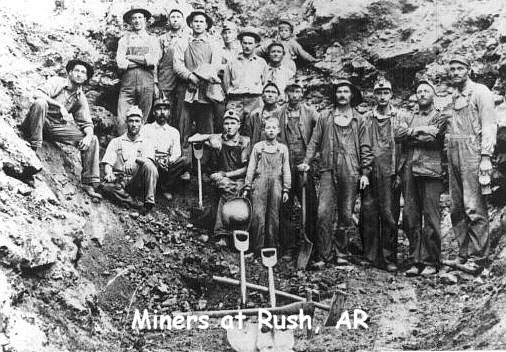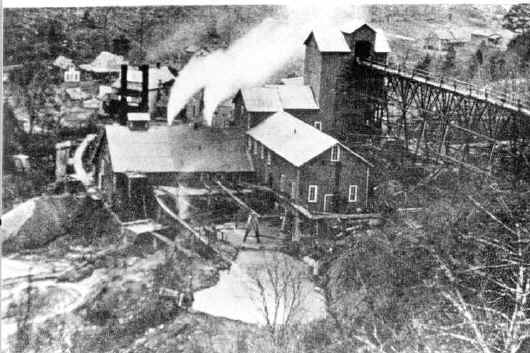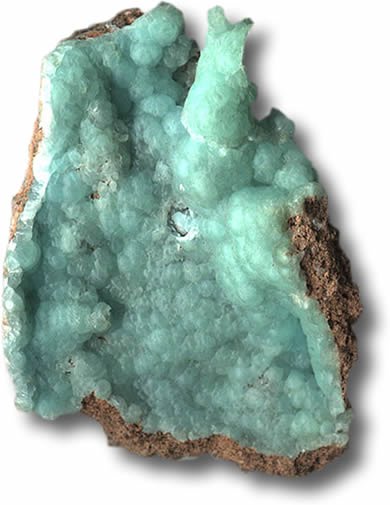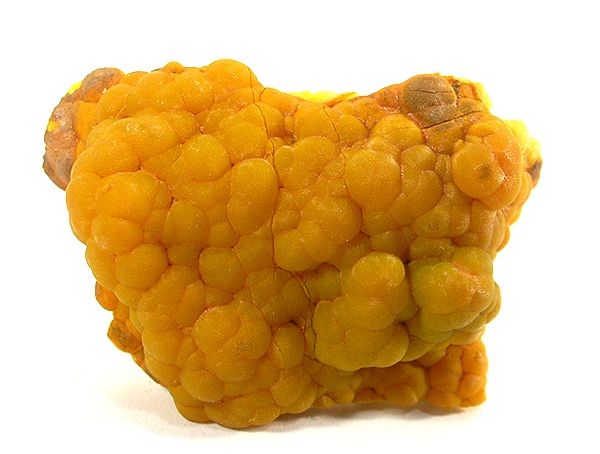What a Rush! EarthCache
-
Difficulty:
-

-
Terrain:
-

Size:  (other)
(other)
Please note Use of geocaching.com services is subject to the terms and conditions
in our disclaimer.

This earthcache is a tribute to my family members who were founders, residents and laborers in this historic mining town. I will forever be fascinated by their stories of Rush, told during my childhood and at family reunions.
Rush, nestled along the lower banks of the beautiful Buffalo National River, in Marion County, was a booming mining town from the late 1880s through the mid 1900s. Now, the ghost town is designated the Rush Historic District by the National Park Service.
In the 1880s, farmers on Rush Creek discovered silver-colored flakes in the stones. A smelter was constructed in 1886, and the rush to Rush began. Claims were staked along the valleys of Rush and Clabber creeks. By the 1890s, the mining boom was well established and people arrived from all over the country.

Farmers, unskilled mechanics, miners, store operators, land speculators, Civil War veterans and even fugitives from the law all sought their fortune, and in some cases, anonymity, in the mines of Rush.
The most famous and productive mine was the Morning Star. Around the mine, homes, a hardware and general store, stables, blacksmith shops, hotels, two saloons, a movie theater, three hotels, churches, a bakery, a telephone exchange, a pharmacy, seven barbers, restaurants and a post office were built, creating the community of Rush.

Morning Star Mine processing mill, 1918
The peak mining period was during World War I when the colorfully-named mines such as White Eagle, Lonnie Boy, Climax, Old Mirror, Bonanza, The Creek Dig, The Hill Dig, Yellow Jacket, Last Chance, Lucky Dutchman, Dixie Girl, Red Cloud, Yellow Rose, Philadelphia, Silver Hollow, Mattie May and the Monte Cristo, were in maximum operation to support the war effort. At one time there were over 5,000 residents and workers in the mountain town.
However, in 1918, with the war's end and the shrinking demand of the metal for national defense, the mine's production declined. The town dwindled as residents and businesses closed. The post office and general store closed in the 1950s, taking the town's identity with it. The last residents relocated in the 1960s and Rush became a memory of a bygone era. Rush is now a protected National Register of Historic Places site and part of the Buffalo National River (video).

Taylor's General Store and the home of Lee Medley, the town's blacksmith, postmaster and Justice of the Peace.
Enjoy the site and walk the short loop around the abandoned Morning Star mine to learn more about the geology and the metal ore mined in Rush. See a gated mine entrance, blacksmith shop, smelter and pieces of the ore near it.

Rush, ca. 1901, and the historic loop trail.




















This Ozark Mountains region contains a specific carbonate ore, mined here for decades.

The mineral type formerly mined here is known as a Mississippi Valley Type (MVT). The largest piece of this carbonate ore was extracted here in 1893. This massive chunk weighs nearly 13,000 pounds. It now resides at the Smithsonian Institute in Washington, D.C.

These commonly-extracted yellow specimens of Smithsonite were known as "turkey fat" by the miners.




















The coordinates are at the loop between the abandoned mine entrance and the smelter. The old ghost town buildings and historical marker are about 750 feet northwest. This is where you will collect the required data.
To log this earthcache, please visit the site and submit your answers to the following questions:
1. What is the name of the specific carbonate ore mined at this site?
2. What are the three words on the last line of the Rush historical marker?
OPTIONAL: Photographs of yourself or surroundings will be met with giddy earthcache-geek excitement.

Resources and credits:
Amethyst Galleries, Inc.
Arkansas Department of Parks and Tourism
Hidden Valley Camp
Pris Weathers, arkansasties.com
Rob Lavinsky, iRocks.com
undergroundozarks.com
Wilma Norton, The USGenWeb Project

Placed by a member of D.A.W.G.S.
Denton Area Wayward Geocache Seekers
Additional Hints
(No hints available.)